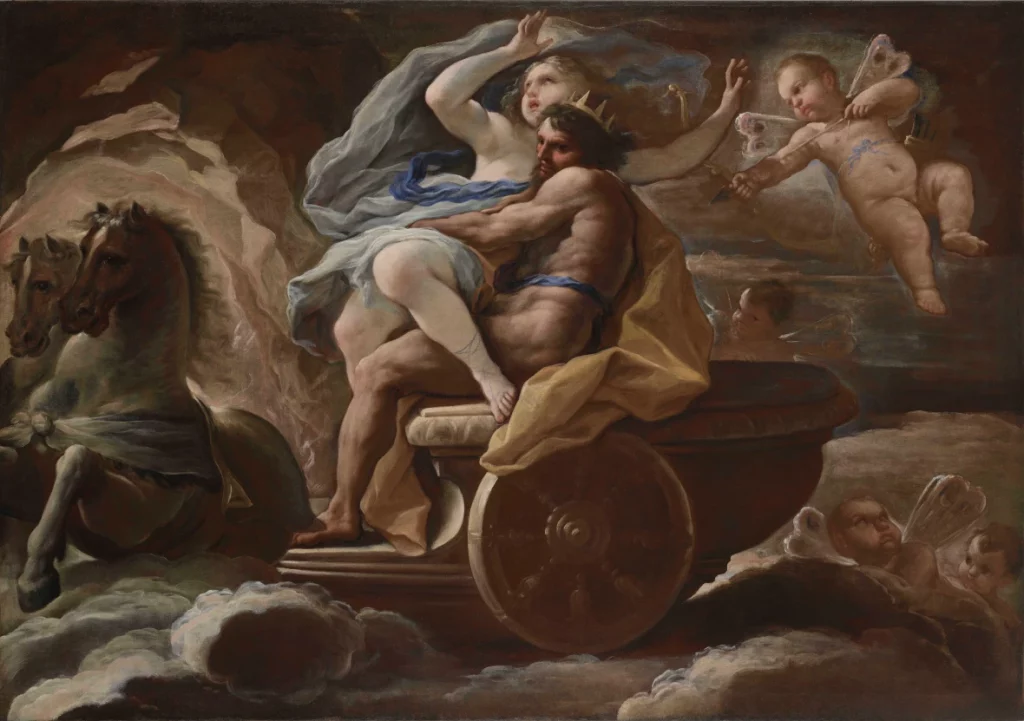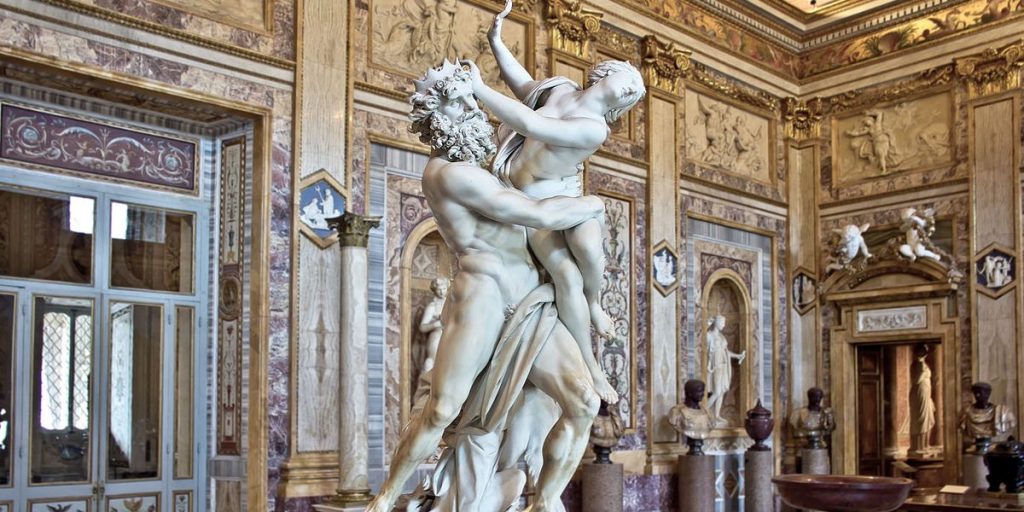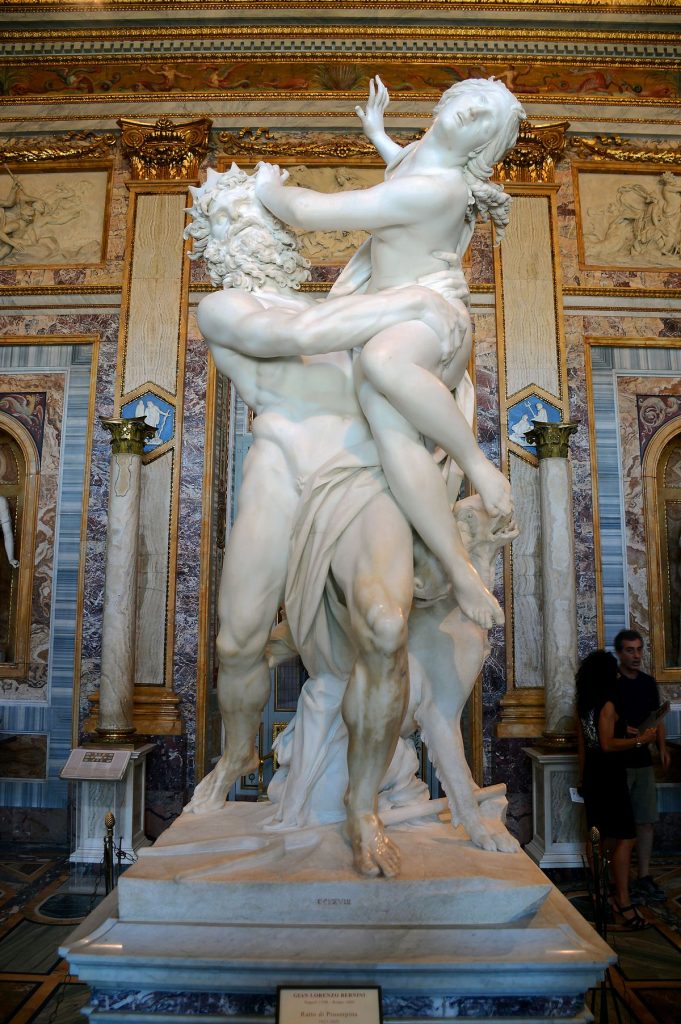Masterpiece Story: L.O.V.E. by Maurizio Cattelan
In the heart of Milan, steps away from the iconic Duomo, Piazza Affari hosts a provocative sculpture by Maurizio Cattelan. Titled...
Lisa Scalone 8 July 2024
13 December 2023 min Read
Sail into the world of antiquity through the eyes of the Baroque artist Gian Lorenzo Bernini. In the Borghese Gallery in Rome, you can find Rape of Proserpina – his 17th-century sculpture which represents his exceptional talent and skill but also a sad mythological story to the audience of the Counter-Reformation era. Bernini easily shaped marble to create a sculpture of beautiful forms and expressions that evoke sadness.
The story behind Bernini’s sculptural group dates back to ancient times. The couple depicted by the sculptor is Pluto and Proserpina according to Roman mythology, or Hades and Persephone according to Greek mythology, and with them is the three-headed dog Cerberus. The event that inspired the sculptor is also the name of the sculptural work itself: Rape of Proserpina.
Proserpina, the daughter of the fertility goddess Ceres and the god of the sky and thunder Jupiter (the deities Demeter and Zeus in Greek mythology), caught the eye of her father’s brother, Pluto, the ruler of the dead, who desired her. While she was gathering flowers in the meadow, Pluto abducted her in his chariot drawn by four black horses and took her to the Underworld. Ceres began an unsuccessful search for her daughter, which resulted in her neglecting her duties and causing the land to dry up and the harvest and crops to fail. Seeing that people were starving and that the land was barren, Jupiter decided to intervene by sending a divine messenger first to Ceres and then to Pluto. The lord of the Underworld seemingly agreed to let Proserpina go, but it was a trick. He gave her pomegranate seeds to eat, and eating these kept her from leaving the Underworld, at least for a while.
According to the myth, when Proserpina is not in the upper world, Ceres takes her gifts away from the world due to her great sadness, and winter sets in. Proserpina returns to her mother in the spring and stays with her for half a year, and everything grows and blooms during this time.

Luca Giordano, The Abduction of Proserpina, between 1634 and 1705, Marquis Michele Arditi di Castelvetere Collection, Naples, Italy. Artsy.
An architect, sculptor and urban planner, Gian Lorenzo Bernini stood out in Baroque Rome thanks to his innovative interpretations and his remarkable dramatic style. At the beginning of his career, he practiced in his father Pietro’s workshop, and later his works were commissioned by the most influential people, such as popes and cardinals. Bernini’s remarkable ability exemplifies 17th-century art.
One of the projects that set him apart from his contemporaries and made him the most eminent among sculptors was the creation of a series of marble sculptures of large proportions. Cardinal Scipione Borghese commissioned them for his villa in Rome, and among them was the Rape of Proserpina. Bernini created it when he was only 23 years old; more precisely, he started the sculpture in 1621, finished it in 1622, and received at least three payments for it. After the completion of the sculptural work, Cardinal Scipione handed the statue over to Cardinal Ludovisi, who in turn moved it to his private villa. It was not until 1908, at the request of the Italian government, that the sculpture was returned to Villa Borghese.

Gian Lorenzo Bernini, The Rape of Proserpina, between 1621 and 1622, Borghese Gallery, Rome, Italy. Le Petit Journal.
The sculpture Rape of Proserpina is made of Carrara marble, but due to its delicate details it does not look like it. The artist managed to faithfully depict human bodies by carving a massive stone block- he even said that the marble in his hands is like wax. We can see this in the precisely crafted muscular body of Pluto and his lush hair and beard that emphasize his strength. He holds Proserpina with his carefully shaped hands as she tries to push him away. She is disgusted by Pluto’s attempt while he has a smile on his face. Bernini presented Proserpina as a desperate woman trying to release herself from her abductor.
The sculptor clearly shows us the figures in motion, one climactic moment captured in time, given that the real bodies cannot maintain the positions they are in the sculpture for more than a second. For example, when looking at Cerberus, the dog guardian of the Underworld, it looks like only one of his three heads is moving. In the Baroque period, there is no more poise of the Renaissance–instead, the intense emotions that come from the understanding of the human body are displayed. The most striking detail that evokes the abduction scene is Pluto holding Proserpina tightly and the fingers of his hand pressing deeply into her thigh. The human body is depicted so faithfully, as if it were not made of a cold stone.
The entire sculpture has an uneven movement and the conflict of desires of the depicted figures is clearly visible. It is the icon of the Baroque era and represents the status and education of its patron, but viewed today, it also symbolizes the universal suffering of women.

Gian Lorenzo Bernini, The Rape of Proserpina, between 1621 and 1622, marble, Borghese Gallery, Rome, Italy. Wikimedia Commons.
DailyArt Magazine needs your support. Every contribution, however big or small, is very valuable for our future. Thanks to it, we will be able to sustain and grow the Magazine. Thank you for your help!